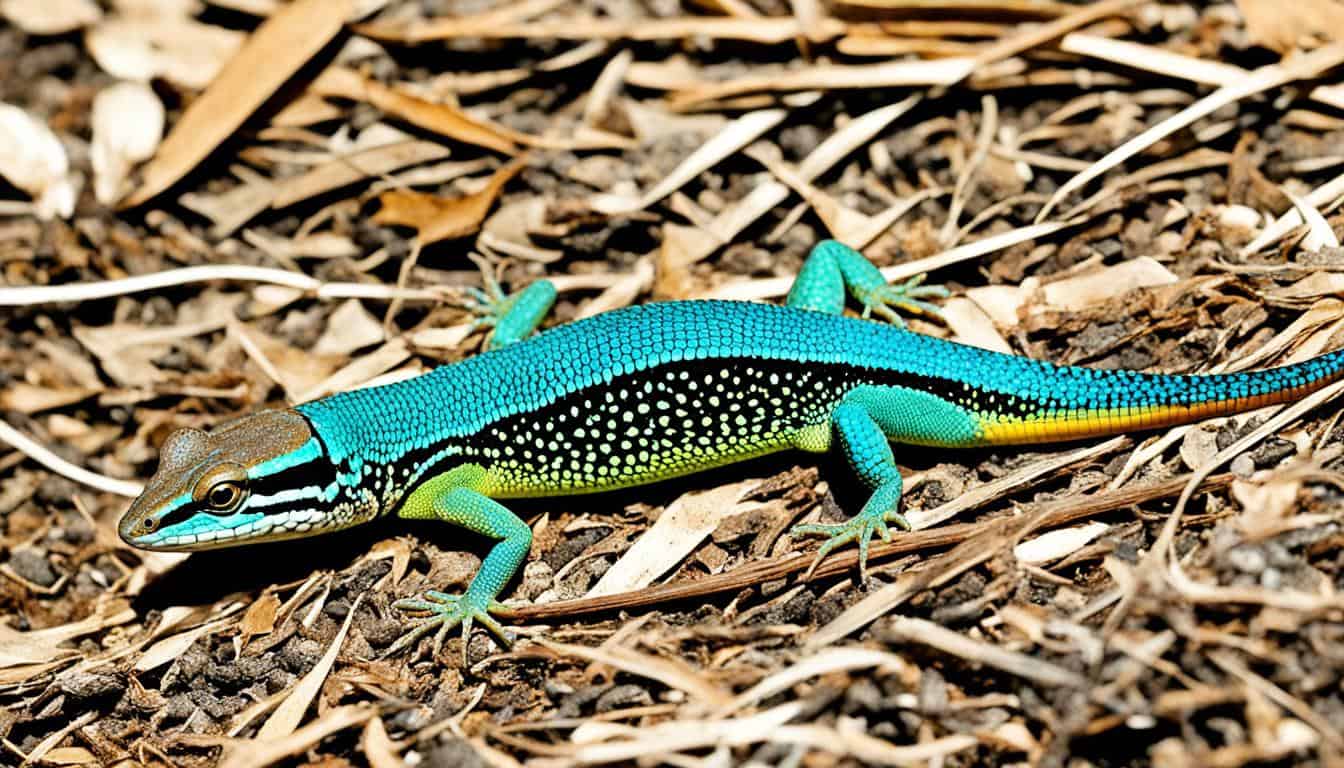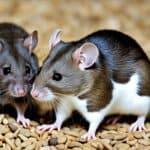Distinguishing between a lizard and a skink involves recognizing their key features. Skinks, like the blue-tailed skink (Eumeces/Plestiodon fasciatus), are part of the Scincidae family. They share with lizards dry, scaly skin and lay eggs on land. Both lizards and skinks love the warmth of the sun.
Skinks are unique because of their even, bony scales and short legs, seen in some types. Young skinks often have colorful tails, like the bright blue tail of the five-lined skink.
Introduction to Reptile Identification
Reptile identification is key for wildlife lovers and experts. Knowing the differences helps spot different reptiles, including the unique features of lizards and salamanders.
Understanding Reptile Families
Lizards and salamanders fall under reptiles but have their own groups. Lizards prefer sunny spots, unlike salamanders who like the dark. This helps tell them apart easily.
Common Misconceptions
Some mix up lizards with newts, which are a kind of salamander. Lizards love the sun, while salamanders hide away during the day. This is an important difference to note.
What Defines a Lizard?
Lizards have unique features that set them apart. They have scaly skin which they shed in parts. Usually, they walk on four legs, each having five toes.
Physical Characteristics of Lizards
Lizards have dry, scaly skin. This is different from snakes that shed skin in one piece. They shed in patches. Lizards generally have four legs with five toes. This helps them move around. While most lizards lay eggs, a few give birth to live young, like the Western fence lizard.
Habitats and Behavior
Lizards vary in how they look and act. Many are fast and agile, making it easy to run from other animals. Some can swim, and some are excellent at digging. They can even lose their tail to get away from a threat. Lizards live in places like deserts and forests. But, they all like warm, dry spots where they can soak up the sun.
Learning about lizard features and habits is valuable. It helps us spot them in the wild. And it shows why these creatures are so interesting.
What is a Skink?
Skinks are a group of reptiles in the Skink Family Scincidae under the infraorder Scincomorpha. They stand out with their unique body shapes and traits. In this section, we will explore what makes skinks special.
Skink Family Scincidae
The Skink Family Scincidae houses a variety of species. They are known for their tiny legs and long bodies. Skinks, unlike most lizards, have a body without a clear neck. This makes them look very streamlined. Among its members are the striking red-eyed crocodile skink and the common five-lined skink.
Unique Traits of Skinks
Skinks have some unique characteristics that show their evolution. For example, some skinks have either small or no limbs, looking like snakes in some cases. Their skulls have scales that fit together, offering protection and a neat appearance.
Many skinks stand out with their bright colors and interesting looks. Take the red-eyed crocodile skink, which has a memorable head and legs. These features not only help skinks survive but also make them appealing to people. They are a rich field of study for both scientists and fans of reptiles.
The Physical Differences Between Lizards and Skinks
It’s important to know the body features of lizards and skinks for telling them apart. One big distinction is their limb and neck sizes. Lizards usually have longer, more defined necks and limbs, making them seem stretched out. Skinks, however, have shorter limbs and less noticeable necks.
Skinks have sleek, tight scales that shine. This is very clear in the five-lined skink, with its bright tail. The bright tail helps them get away from predators. These features are interesting and key for separate lizard from skink.
| Feature | Lizards | Skinks |
|---|---|---|
| Limb Length | Longer | Shorter |
| Neck Definition | More defined | Less pronounced |
| Scale Structure | Varied | Streamlined and cohesive |
| Juvenile Tail Color | Less vibrant | Bright-colored |
When trying to figure out if it’s a lizard or skink, look closely. Limbs, necks, and scales can give you hints. They are very helpful for telling the difference.
Behavioral Distinctions
Looking at how lizards and skinks behave helps us tell them apart. We’ll see what these animals do to stay warm and active.
Activity Patterns
Lizards and skinks act differently based on their species. But, most of them, like skinks and many lizards, are active during the day. Skinks, especially the five-lined skink, love the sun; they often bask on logs or rocks. This sunbathing is how they keep their bodies at the right temperature for their health.
Sunbathing and Thermoregulation
Basking in the sun is key for many lizards and skinks to stay warm. Since they are day creatures, they depend on the sun’s warmth. Lizards bask all day, but skinks are more sneaky and find sunny spots in the afternoon. This way, they make sure they’re always at the perfect temperature to be active and stay well.
Habitat Preferences
It’s important to know where reptiles like to live to ID them. Lizards and skinks pick different spots even though they’re in the reptile family.
Lizard Habitats
Lizards are found everywhere, from dry deserts to green forests. They love sunny, warm places to keep their bodies at the right temp. You’ll see lizards on rocks, in fields, and around towns, soaking up the sun.
Skink Habitats
Skinks, on the other hand, prefer places with more moisture like wet forests, rock piles, and leaf cover. The five-lined skink often hangs out near clay pots or on the west side of buildings. They like the sun in the evening hours.
| Comparison Aspect | Lizard Habitats | Skink Habitats |
|---|---|---|
| Typical Environments | Deserts, forests, rocky outcrops, urban areas | Moist wooded areas, rock piles, leaf litter |
| Sunbathing Preferences | Sunny, warm spots | Late afternoon sun |
| Cover Preferences | Open fields, urban structures | Clay pots, shaded areas |
Knowing these differences can help you spot if it’s a lizard or skink when you’re out there.
How do you distinguish between a lizard and a skink?
Distinguishing a lizard from a skink is straightforward when you know what to look for. Focus on their looks and how they act. Skinks usually have slick, similar scales and look like they have no neck. This makes them stand out in the reptile classification world.
Young skinks might have bright tails like the blue ones on five-lined skinks. But, when skinks grow up, their colors become dull. This change makes it easier to know they’re skinks, even though some lizards change less as they get older.
How they act is key in telling lizards and skinks apart, too. Skinks like certain places to live and have special habits, like sunning themselves. Knowing where they like to be and what they do can help you figure out if it’s a skink.
| Characteristic | Lizards | Skinks |
|---|---|---|
| Scales | Varied, often rougher | Sleeker, more uniform |
| Limbs | Longer limbs | Shorter limbs |
| Neck | More defined | Reduced or absent |
| Coloration | Consistent throughout life stages | Brighter in juveniles, duller in adults |
| Preferred Habitat | Varied, often dry environments | Moist wooded areas, leaf litter |
| Sunbathing | Common, varied times | Often late afternoon |
Dietary Habits
Lizards and skinks mainly eat insects but their food choices vary. This depends on the type of lizard and its surroundings.
What Lizards Eat
Most lizards eat insects. This includes ants, beetles, and grasshoppers. Some lizards may also eat small animals, birds, or other lizards. A few will eat plants if there aren’t enough insects. By looking at what lizards eat, scientists learn about their lives and habits.
Skink Dietary Preferences
Skinks are also big fans of bugs. They eat a lot of different insects such as beetles and earthworms. Some skinks, like the five-lined skink, eat other lizards or even small mice. On the flip side, the Western skink likes to find its food under things like rocks or logs.
| Reptile | Primary Diet | Additional Foods |
|---|---|---|
| Lizards | Insects | Small mammals, birds, plants |
| Five-lined Skink | Invertebrates | Other lizards, small mice |
| Western Skink | Invertebrates | Insects under rocks and logs |
Reproduction and Lifecycles
Lizards and skinks have special ways of reproducing. Knowing about these helps us understand how they breed. They each show different habits when it comes to making nests and caring for their young.

Egg Laying vs. Live Birth
A major split in how reptiles carry on their families is whether they lay eggs or give birth live. The five-lined skinks are females that lay eggs. These hatch from June to August. On the flip side, the Western fence lizard has their babies alive instead of eggs.
Nesting Behaviors
Where skinks and lizards place their young-to-be is crucial. The moms show a lot of care, keeping the eggs safe until they hatch. They look for good spots to lay their eggs, like under things, in thick plants, or under leaves. This care helps their babies grow strong and safe.
| Aspect | Five-Lined Skink | Western Fence Lizard |
|---|---|---|
| Reproductive Type | Oviparous (Egg Laying) | Viviparous (Live Birth) |
| Egg/Nest Location | Underneath structures, dense foliage | N/A – Live Birth |
| Nesting Behavior | Female guards eggs | Not applicable |
Examples of Common Lizards and Skinks
When you explore different places, you may see many kinds of lizards and skinks. It’s fascinating to learn about their features and where they live. This knowledge helps us respect the wide variety of reptiles out there.
Lizards You Might Encounter
The Western fence lizard is easy to spot, with its bumpy scales and love for sun. You might also come across alligator lizards and horned lizards in certain places. Each type has special traits, such as the alligator lizard’s long tail and the horned lizard’s spikes.
Popular Skink Species
The five-lined skink is well-known for its electric blue tail when young. This color fades as they get older. Then there’s the Western skink, which shines with its glossy scales. You can spot Western skinks under rocks or logs in damp, wooded spots.
Watching lizards sunbathe or seeing young skinks with their bright tails is truly interesting. They show us the amazing variety of life around us.
The Role of Skinks in the Ecosystem
Skinks are small but they’re key players in their environments. They are essential for managing pests. By eating insects, like beetles and spiders, they control their population. This action helps keep the ecosystem in balance. It’s good for the plants and animals that live there.
Pest Control
Skinks are natural protectors against pests. They eat a lot of insects. This makes them great for farms and gardens. They reduce the need for harmful pesticides. Plus, they prevent damage to plants. This helps the areas they live in stay diverse and healthy.
Predator and Prey Dynamics
Skinks are both hunters and the hunted. They catch insects, but birds, snakes, and small mammals also eat them. This shows how they fit into the food chain. Their presence indicates a balanced ecosystem. Here, both predators and prey can live well. Skinks play a part in keeping nature resilient.
Knowing what skinks do helps in protecting them. They are important for keeping the ecosystem healthy. Their jobs in controlling pests and being part of the food chain show nature’s balance. It’s essential to let them keep doing their important work.
FAQ
How do you distinguish between a lizard and a skink?
Skinks have smooth, uniform scales and shorter limbs. They might not have a distinct neck. Young skinks, like the blue-tailed skink, have bright tails. Lizards usually have a more visible neck and longer legs.
What are the differences in reptile classifications?
Lizards have dry, scaly skin and lay eggs on dry land. Amphibious salamanders need water for reproduction and have wet skin.
What are common misconceptions in reptile identification?
Newts are sometimes mistaken for lizards, but they’re different. Lizards are active during the day and newts at night. Also, lizards have dry skin while newts’ skin stays moist.
What defines a lizard’s physical characteristics?
Lizards have scales, can shed, and usually have four legs. They often lay eggs and might drop their tails to escape danger. They live in various places, from deserts to forests, enjoying warm, sunny areas.
What are the unique traits of skinks?
Skinks, like the five-lined skink, are known for their small limbs and lack of a clear neck. They use their bright tails for protection. Their skulls have tight-fit bony scales.
What are the physical differences between lizards and skinks?
Skin and neck size set lizards and skinks apart. Skinks have sleek scales with less-defined necks and short limbs. Lizards, though, usually have longer limbs and a more visible neck.
What are the behavioral distinctions between lizards and skinks?
Skinks are more private and come out during the day. They sunbathe to stay warm. Lizards, while also sunbathing, show more action, some even swim.
What are the habitat preferences of lizards and skinks?
Lizards like deserts and forests, picking sunny, warm places. Skinks, on the other hand, prefer damp, wooded spots, hiding under rocks or in leaves. They enjoy the late afternoon sun and sheltered areas.
What do lizards and skinks eat?
Lizards mostly eat insects but also snack on plants. Skinks, too, eat bugs but add in earthworms and small animals. There are some exceptions, like the five-lined skink, which might eat other small lizards or mice.
How do their reproductive strategies differ?
Lots of differences exist in how lizards and skinks reproduce. Five-liners lay eggs, which hatch in summer, but some lizards, like the Western fence lizard, have live babies. They both protect their eggs until they hatch.
What are examples of common lizards and skinks?
Common lizards include the Western fence lizard and the alligator and horned lizards. Skink species also vary, with the five-lined skink being widely known, and the Western skink in certain areas.
What role do skinks play in the ecosystem?
Skinks are key in balancing nature. They eat many bugs, helping to control pests. Birds and small mammals eat skinks, tying them into the food web.







